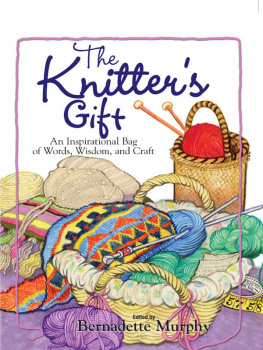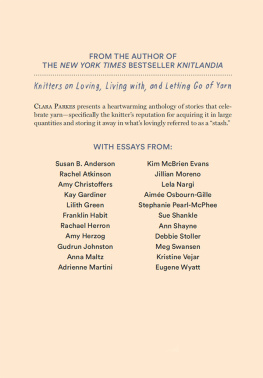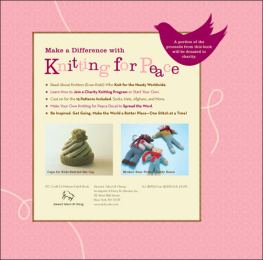KNITTING
MEMORIES
REFLECTIONS ON THE KNITTERS LIFE

Edited by Lela Nargi
Voyageur Press
First published in 2006 by Voyageur Press, an imprint of MBI Publishing Company, 400 First Avenue North, Suite 300, Minneapolis, MN 55401 USA
Copyright 2006, 2010 by Lela Nargi
Hardcover edition published in 2006. Digital edition 2010.
All rights reserved. With the exception of quoting brief passages for the purposes of review, no part of this publication may be reproduced without prior written permission from the Publisher.
The information in this book is true and complete to the best of our knowledge. All recommendations are made without any guarantee on the part of the author or Publisher, who also disclaim any liability incurred in connection with the use of this data or specific details.
We recognize, further, that some words, model names, and designations mentioned herein are the property of the trademark holder. We use them for identification purposes only. This is not an official publication.
MBI Publishing Company titles are also available at discounts in bulk quantity for industrial or sales-promotional use. For details write to Special Sales Manager at MBI Publishing Company, 400 First Avenue North, Suite 300, Minneapolis, MN 55401 USA
To find out more about our books, visit us online at www.voyageurpress.com .
Digital edition: 978-1-61673-992-8
Hardcover edition: 978-0-7603-2648-0
Knitting memories: reflections on the knitters life/edited by Lela Nargi.
p. cm.
Includes bibliographical references.
ISBN-13: 978-0-7603-2648-0
ISBN-10: 0-7603-2648-7
1. Knitting. 2. Knitters (Persons)United States. I. Nargi, Lela.
TT820.K6998 2006
746.43'2dc22
Project Editor: Kari Cornell
Designer: LeAnn Kuhlmann
Printed in China
As ever, for my adoring, adorable family:
Robbie, Ada, Mom, Jaffa, Sigi


ACKNOWLEDGMENTS
As is the case with all the most fortuitous circumstances of my life, I stumbled into the world of knitting completely by accident. One accident led to another, and here I am, at the helm of a second book about knitting, dazed to realize that this miraculous, generous world continues to sustain me in ways both practical and ephemeral. It is impossible to say where this generosity begins, and it certainly seems to have no end. But here I will start by thanking Kari Cornell and the editors at Voyageur Press for taking on this project with unflagging enthusiasm. And go on to thank all the knitters and non-knittersold friends and newwho practically donated their exquisite writings and drawings to this project. And conclude, at least for the moment, by thanking the wide universe of knitting, for creating a small niche in which I can live and write and knit and be happy.
CONTENTS
by Lela Nargi
by Elanor Lynn
by Cedric N. Chatterley
by Betty Christiansen
by Clara Parkes
by Diane Mennella
by Eiko Berkowitz
by Caroline Herzog
by Lydia Vivante
by Kathryn Alexander
by Reine Wing Hewitt
by Teva Durham
by Robert Bruce Cowan
by Lily M. Chin
by Jennifer Brown
by Veda Alban

INTRODUCTION
From the time she was very, very small, just beginning to form words and steps, my daughter, Ada, has possessed the curious ability to recognize the hand-knit bits and garments strewn throughout our household. With no conscious cues from her knit-loving mother, she is, nevertheless, drawn to them. No, more than drawn to them, fiercely determined to have these things neararound her, over her, under her headas though their fibers and her own were made of the same stuff.
The first such object of her infatuation was a variegated sweater made for her as a newborn. For over a year, she insisted on being stuffed into this sweater until it held her arms and belly as tightly as sausage casing. If ever I tried to dress Ada in another, she shrieked and flailed, then fell limp in a useless deadweight. I stopped trying. It was (isa plush penguin wears it now) a beautiful sweater. Soft gradations of pink and lavender and pale green are topped with a lettuce-leaf collar; antique oval mother-of-pearl buttons punctuate the front; a bit of moss stitch peppers each border. But what does a toddler know or see of such details?
At night, as I tuck her in for sleep, she calls off her unvarying list of items she must have surrounding her, in addition to all the usual bedding: pillow!, a small rectangle topped with an angora and mohair splotch that was my first-ever attempt at knitting; pink blanket!, really a pink and yellow patchwork of flowers and trees and fanciful foliage ringed by a tasseled border, made by a doting auntie; blue blanket!, the work of another auntie, patterned with alternating stripes of cream and midnight and light blue. When all have been gathered and arranged, Ada appears as a plumped and wildly uncomfortable miniature maharani, crookedly half-leaning against a tall stack of pillows, sweating beneath one down comforter and a slathering of wool blankets. Under penalty of gruesome toddler meltdown, everything has been painstakingly ordered with no wrinkles, no gaps, tassels just so.
Two years old at this writing, Ada is now tall enough and dexterous enough to open and rummage through dressers, cabinets, armoires. She has managed to unearth a little veststill too large for herknitted by some Italian friends. Among the stacks of sweaters and shirts and onesies and pants and skirts and tights, Ada espied this garment, yanked it out, and has begun using it to tuck a favorite doll into a miniature stroller. It is a somewhat unremarkable piece, comprising two white and magenta striped panels knitted flat and stitched together. I try to fathom what about this vest has caught Adas attention. Does she remember our Italian friends from the time we spent in their company almost a year ago, remember them measuring and plotting and finally finishing this vest with droplets of crochet? I doubt it, and yet... who knows? It seems more likely, though, as was the case with her beloved pink sweater, that she somehow recognizes this garment as something handmade and made with her in mind. In the evening, sitting up on the couch in front of a favorite movie and munching a snack, Ada suddenly demands that her little blanket, as shes taken to calling this simple rectangle she has yet to wear, be brought to her. I retrieve it from the stroller to tuck around her legs. As she alternately watches and munches, Ada takes a second or two to retuck the vest just so, to smooth its edges, stroke its contours.
Admittedly, there are a lot of knitted things in our house. With the enthusiastic input of dozens of knitters around the country, I wrote a book about knitting shortly before I became pregnant with Ada, and when she was born, knitted gifts abounded. This may play some small part in her ability to recognize knitting. But there are many other kinds of handmade things in our house: paintings by Adas father and numerous friends hang on the walls; curious little assemblages top tables and are tucked into shelves; Adas ancestors built some of our furniture; Ive sewn the curtains. What is it about the knitted things so particularly that calls to her?









